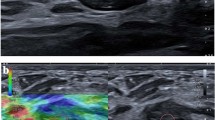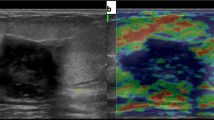Abstract
We evaluate the correlations between tumor strain ratio value and prognostic factors for breast cancers. Fifty-seven women with invasive breast cancer underwent ultrasound elastography prior to surgery. Elastography strain ratio (SR), defined as the fat-to-lesion ratio, was recorded for each lesion using the software in the ultrasound equipment. We evaluated the associations between tumor SR and pathological prognostic factors such as tumor subtype, tumor size, axillary lymph node metastasis, histological grade, vascular invasion, and hormonal receptor status. We found a significant correlation between tumor SR and progesterone receptor (PR) status (p = 0.02). Tumors with axillary lymph node metastasis had a higher SR value than those without lymph node metastasis; however, this difference was not significant. Strain elastography revealed that grade 3 tumors had softer tissues than grade 1 and 2 tumors, although this was not statistically significant. The tumor SR value was not significantly correlated with tumor subtypes, tumor size, vascular invasion, and estrogen receptor or cell surface human epidermal growth factor 2 status (p > 0.05). The present study demonstrated no significant correlation between SR values and prognostic factors, except for PR status. However, tumors with LN metastasis tended to exhibit greater stiffness, and higher grade tumors exhibited lower stiffness owing to necrosis. Further studies with large study population on tumor-associated stiffness are required.


Similar content being viewed by others
References
Itoh A, Ueno E, Tohno E, Kamma H, Takahashi H et al (2006) Breast disease: clinical application of US elastography for diagnosis. Radiology 239(2):341–350. https://doi.org/10.1148/radiol.2391041676
Cho N, Moon WK, Kim HY, Chang JM, Park SH et al (2010) Sonoelastographic strain index for differentiation of benign and malignant nonpalpable breast masses. J Ultrasound Med 29(1):1–7. https://doi.org/10.7863/jum.2010.29.1.1
Barr RG (2018) The role of sonoelastography in breast lesions. Semin Ultrasound CT MR 39(1):98–105. https://doi.org/10.1053/j.sult.2017.05.010
Chang JM, Won JK, Lee KB, Park IA, Yi A et al (2013) Comparison of shear-wave and strain ultrasound elastography in the differentiation of benign and malignant breast lesions. Am J Roentgenol 201(2):W347–W356. https://doi.org/10.2214/AJR.12.10416
Elston CW, Ellis IO, Pinder SE (1999) Pathological prognostic factors in breast cancer. Crit Rev Oncol Hematol 31(3):209–223. https://doi.org/10.1016/s1040-8428(99)00034-7
Barr RG, Silvestri AD, Scotti V, Manzoni F, Rebuffi C et al (2019) Diagnostic performance and accuracy of the 3 interpreting methods of breast strain elastography. A systematic review and meta-analysis. J Ultrasound Med 38(6):1397–1404. https://doi.org/10.1002/jum.14849
Grajo JR, Barr RG (2014) Strain elastography for prediction of breast cancer tumor grades. J Ultrasound Med 33(1):129–134. https://doi.org/10.7863/ultra.33.1.129
Kim JY, Shin JK, Lee SH (2015) The breast tumor strain ratio is a predictive parameter for axillary lymph node metastasis in patients with invasive breast cancer. Am J Roentgenol 205(6):W630-638. https://doi.org/10.2214/AJR.14.14269
Evans A, Whelehan P, Thomson K, McLean D, Brauer K et al (2012) Invasive breast cancer: relationship between shear-wave elastographic findings and histologic prognostic factors. Radiology 263(3):673–677. https://doi.org/10.1148/radiol.12111317
Gemici AA, Ozal ST, Hocaoglu E, Inci E (2020) Relationship between shear wave elastography findings and histologic prognostic factors of invasive breast cancer. Ultrasound Q 36(1):79–83. https://doi.org/10.1097/RUQ.0000000000000471
Hayashi M, Yamamoto Y, Ibusuki M, Fujiwara S, Yamamoto S et al (2012) Evaluation of tumor stiffness by elastography is predictive for pathologic complete response to neoadjuvant chemotherapy in patients with breast cancer. Ann Surg Oncol 19(9):3042–3049. https://doi.org/10.1245/s10434-012-2343-1
Pinder SE, Ellis IO, Galea M, O’ Rouke S, Blamey RW, et al (1994) Pathological prognostic factors in breast cancer. III. Vascular invasion: relationship with recurrence and survival in a large study with long-term follow-up. Histopathology 24(1):41–47. https://doi.org/10.1111/j.1365-2559.1994.tb01269.x
Wolff AC, Hammond ME, Schwartz JN, Hagerty KL, Allred DC et al (2007) American Society of Clinical Oncology/College of American Pathologists guideline recommendations for humanepidermal growth factor receptor 2 testing in breast cancer. J Clin Oncol 25(1):118–145. https://doi.org/10.1200/JCO.2006.09.2775
Hammond ME, Hayes DF, Wolff AC, Mangu PB, Temin S (2010) American Society of Clinical Oncology/College of American Pathologists guideline recommendations for immunohistochemical testing of estrogen and progesterone receptors in breast cancer. J Oncol Prac 6(4):195–197. https://doi.org/10.1200/JOP.777003
Hayashi M, Yamamoto Y, Sueta A, Tomiguchi M, Yamamoto-Ibusuki M et al (2015) Associations between elastography findings and clinicopathological factors in breast cancer. Medicine 94(50):1–9. https://doi.org/10.1097/MD.0000000000002290
Evans A, Sim YT, Pourreyron C, Thompson A, Jordan L et al (2018) Pre-operative stromal stiffness measured by shear wave elastography is independently associated with breast cancer-specific survival. Breast Cancer Res Treat 171(2):383–389. https://doi.org/10.1007/s10549-018-4836-5
Gervin E, Shin B, Opperman R, Cullen M, Feser R et al (2020) Chemically induced hypoxia enhances miRNA functions in breast cancer. Cancers (Basel) 12(8):2008. https://doi.org/10.3390/cancers12082008
Youk JH, Son EJ, Gweon HM, Kim H, Park YJ et al (2014) Comparison of strain and shear wave elastography for the differentiation of benign from malignant breast lesions, combined with B-mode ultrasonography: qualitative and quantitative assessments. Ultrasound Med Biol 40(10):2336–2344. https://doi.org/10.1016/j.ultrasmedbio.2014.05.020
Kim HJ, Kim SM, Kim B, Yun BL, Jang M et al (2018) Comparison of strain and shear wave elastography for qualitative and quantitative assessment of breast masses in the same population. Sci Rep 8(1):6197–6208. https://doi.org/10.1038/s41598-018-24377-0
Ma Y, Zhang S, Li J, Ye K, Ren W (2017) Comparison of strain and shear-wave ultrasonic elastography in predicting the pathological response to neoadjuvant chemotherapy in breast cancers. European Radiolology 27(6):2282–2291. https://doi.org/10.1007/s00330-016-4619-5
You Y, Song Y, Li S, Ma Z, Bo H (2019) Quantitative and qualitative evaluation of breast cancer prognosis: a sonographic elastography study. Med Sci Monit 25:9272–9279. https://doi.org/10.12659/MSM.918806
Zheng X, Huang Y, Liu Y, Wang Y, Mao R et al (2020) Shear-wave elastography of the breast: added value of a quality map in diagnosis and prediction of the biological characteristics of breast cancer. Korean J Radiol 21(2):172–180. https://doi.org/10.3348/kjr.2019.0453
Berg WA, Mendelson EB, Cosgrove DO, Dore CJ, Gay J et al (2015) Quantitative maximum shear-wave stiffness of breast masses as a predictor of histopathologic severity. Am J Roentgenol 205(2):448–455. https://doi.org/10.2214/AJR.14.13448
Chammings F, Latorre-Ossa H, Le Frére-Belda MA, Fitoussi V, Quibel T et al (2013) Shear wave elastography of tumour growth in a human breast cancer model with pathological correlation. Eur Radiol 23(8):2079–2086. https://doi.org/10.1007/s00330-013-2828-8
Barr RG (2019) Future of the breast elastography. Ultrasonography 38(2):93–105. https://doi.org/10.14366/usg.18053
Funding
This work was supported by the 2019 Baskent University research fund.
Author information
Authors and Affiliations
Corresponding author
Ethics declarations
Conflict of Interest
The authors declare no competing interests.
Additional information
Publisher's Note
Springer Nature remains neutral with regard to jurisdictional claims in published maps and institutional affiliations.
Rights and permissions
About this article
Cite this article
Karan, B., Purbager, A. Association of Tumor Strain Ratio with Prognostic Factors in Invasive Breast Cancer. Indian J Surg 84, 1239–1244 (2022). https://doi.org/10.1007/s12262-021-03263-6
Received:
Accepted:
Published:
Issue Date:
DOI: https://doi.org/10.1007/s12262-021-03263-6




